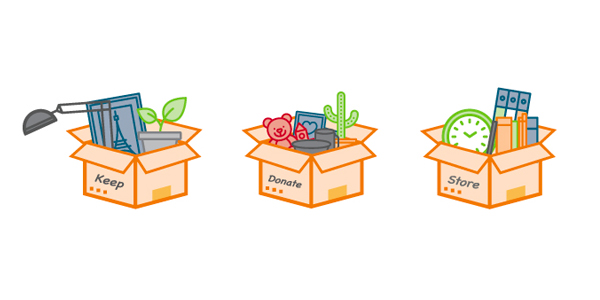How to Downsize Your Home Before a Move

How to Downsize Your Home Before a Move
Living in a large house is great for some families, but for others, the cost and effort of maintenance is a burden. This is especially true after your kids have grown up and moved out. If you’re overwhelmed in your current home, moving to a smaller space can be a great move both financially and mentally.
However, decluttering and downsizing can be a daunting task. Downsizing to a smaller home and need some help getting started? Follow our best tips for a stress-free move.
7 Most Effective Downsizing and Decluttering Tips
1. Take Inventory of Your Belongings
When you’re downsizing to a smaller home, you naturally won’t have as much space for all the items you’ve accumulated throughout the years. Before you start packing, you’ll need to take inventory of your belongings.
As you sort through everything, it’s important to separate aspirational items from the ones you actually need. If you come across something you haven’t used in the last year, you should probably get rid of it. And if you didn’t even know you still had an item in question, it’s definitely time to let it go. The purpose of downsizing is to simplify your life, so take only what you need with you.

Start decluttering in 3 simple steps. First, set a timeline and goals for your project. Then, create a sorting system for going through your belongings. Once you’ve decided what to keep and what to part ways with, you can purge your house of the clutter. Find more expert tips on room-by-room organizing and decluttering in our ridiculously thorough home declutter guide.

2. Sort Through Items Room-by-Room and Minimize Duplicates
As you go through your belongings, you’ll need to set up a system to stay organized. We recommend the Three-Box Method, which forces you to make a decision item-by-item. Gather three boxes or bins and label them as “Keep,” “Get Rid Of,” and “Put In Storage.”
You should keep items that are useful in your daily life. Once you’ve filled your “Keep” box in each room, you can pack it up and label it to make moving and unpacking easier.
Get rid of items that you no longer have a use for. Once you’ve defined the items you’re getting rid of in each room, you can sort them further by identifying what will be donated or passed down to family members, and what is worn or broken and should be thrown away.
Sentimental or seasonal items should be put in storage. After you complete each space, empty the “Put In Storage” box into neatly labeled storage containers.

In each space, look at which items you have multiples of and only keep your favorites, or the ones that aren’t damaged. The kitchen is typically a clutter hotspot for duplicate items, so pay extra attention when decluttering this area.
3. Create a Plan to Get Rid of Unwanted Items
Once you’ve identified which items aren’t coming with you to your new home, you have several options for getting rid of them:
- Donate or Freecycle: Give something you no longer need to someone who does. Local charities usually accept clothing, shoes and other household items that are in good condition. You can also try posting to freecycle.org or a Facebook resale group.
- Have a Yard Sale: One person’s trash is often another person’s treasure. If you’re downsizing a lot of your belongings before the move, consider having a yard sale to make some extra cash. Furniture, toys, books, kids’ clothes, power tools and lawn equipment are usually popular items at a garage sale.
- Rent a Dumpster: Chances are, not everything you’re getting rid of will be in good enough condition to donate or sell. Renting a dumpster is a stress-free option if you have a lot to downsize and declutter, or if you’re throwing away larger household items, like broken appliances or tattered furniture.
- Pass Down to Loved Ones: It’s difficult to declutter sentimental items you no longer have use for but that hold years of memories. If there are family heirlooms in good condition that you feel a family member or friend would enjoy, offer to give them as a gift.

As you say goodbye to belongings, try to preserve the memory or emotion behind each one by:
Taking a picture.
Writing a description of the item and the memory it evokes.
Passing it along to a family member who actually wants it.
Donating it to a charity for people in need.
Turning it into something useful like a quilt.

4. Go Digital When Possible
Over the years, paper clutter can really add up. Make time to sort through old bills, receipts and other documents, and recycle anything you don’t need. Store older paper files, such as taxes from the last decade, in a plastic bin. Scan any other records and receipts you may need in the future so you have a digital copy, then shred and throw them away.
Home movies, music and photos can also be converted into digital files. This will free up a lot of valuable real estate in your living room and office without having to part with things you’d otherwise keep. In the world of endless streaming services, it’s probably not worthwhile to hang onto VHS tapes, scratched DVDs or CDs. When in doubt, throw them out (or recycle them).
Looking for more moving tips? Check out our Complete Checklist for Moving Out of Your Home!
5. Make the Most of Your Storage Spaces
When you’re downsizing to a smaller home, it’s important to maximize any storage space you have. While not every home has designated storage areas like a basement, attic or garage, here are some general tips to keep in mind:
- Create built-in storage options whenever you can. Multifunctional furniture such as storage ottomans, platform beds with drawers, entertainment centers, wardrobes, bookshelves and baskets are all helpful for hiding and minimizing clutter, but traditional shelving units are always a great option too.
- Use open wall space. Floating shelves are great for displaying knickknacks around the house, as well as adding storage in your kitchen, bedroom and bathroom.
- Take advantage of hidden storage spaces. Utilize extra areas in your new home, such as under the stairs, closets and crawl spaces to store seasonal or sentimental items. Add floating shelves or cubbies, and stack clear plastic bins in these hidden spots to make the most of the space and easily find what you need. You can also get creative with adding storage to small bathrooms by adding over-the-door hooks, towel racks, standalone shelves and bins for under-counter storage, an over-the-toilet shelving unit and a medicine cabinet.
6. Measure Furniture and Wait to Buy New Things
You may not have enough room in your new, smaller home to fit all of your current furniture. While taking inventory of your belongings, measure your furniture to see if and how it will fit in your new space, or if you’ll need to part with any of it. It’s much easier to figure this out ahead of time, rather than moving a sectional couch into your new home to find it doesn’t fit.
For this same reason, you should also avoid buying new items until you get a sense of the space you’re working with in the new home.

7. Give Yourself Plenty of Time
Part of figuring out how to downsize is figuring out when to downsize. Decluttering is a journey, so give yourself more time than you think you’ll need to plan for the move and downsize your belongings. Eliminate the stress of rushing to purge everything, and allow yourself to reflect and make rational decisions on what to downsize and declutter.
Finally, don’t be afraid to ask for help while downsizing. Recruit family and friends, or even hire a professional service to assist with clearing out your house and moving into your new home.
Unsure how to design your new small home? Check out our 19 Tips to Maximize Space in a Small House!



